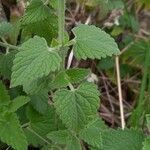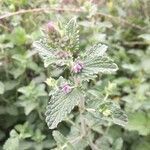Densely hairy perennial, with stems erect or nearly so, to c. 1 m tall. Petioles to 3 cm long. Lamina 4-6 × 3-4 cm, ovate or triangular-ovate, often grey-tomentose, deeply serrate or crenate-serrate; base cordate or subcordate; apex mucronate; upper cauline lvs smaller. Infl. terminal, dense, spike-like, with lower verticels distant. Calyx 6-7 mm long, tomentose outside on nerves; teeth linear-subulate, often purplish tipped. Corolla usually 7-10 mm long to apex of upper lip, white with purplish dots on lower lip; tube somewhat curved, not exceeding calyx, tomentose outside; limb tomentose outside; upper lip with 2 rounded lobes. Anthers usually purplish, sometimes green. Style white or pale mauve. Nutlets c. 1.5 mm long, broad-oblong, dark brown, faintly ridged.
Taprooted perennial; 3–10 dm, branched above, finely and densely canescent throughout; lvs all cauline, triangular-ovate, cordate or truncate at base, 3–8 cm, coarsely toothed, the petiole half as long as the blade; fl-clusters 2–6 cm, continuous or interrupted, rather loosely many-fld; cal at anthesis 5–7 mm, weakly bilabiate, the lobes half as long as the tube; cor 8–12 mm, dull white, dotted with pink or purple, the lower lip crenulate; 2n=32, 34, 36. Native of Eurasia, now established in disturbed habitats throughout our range and w. July–Oct.
A herb which keeps growing from year to year. The leaves are hairy and grey-green. It grows 90 cm high. The leaves are oval and 5-7 cm long. The leaves have teeth or are scalloped along the edge. The flowers are white and occur in spikes. They have pale purple spots.
Corolla white, red-dotted.









